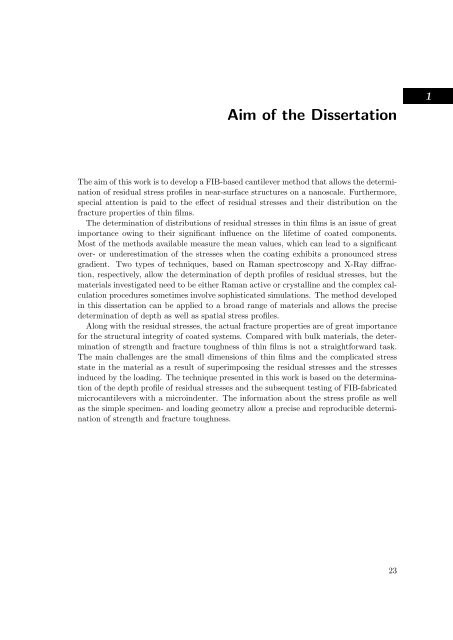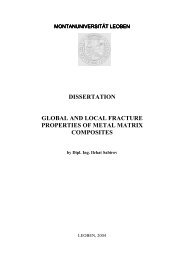1 - Erich Schmid Institute
1 - Erich Schmid Institute
1 - Erich Schmid Institute
Create successful ePaper yourself
Turn your PDF publications into a flip-book with our unique Google optimized e-Paper software.
Aim of the Dissertation<br />
The aim of this work is to develop a FIB-based cantilever method that allows the determination<br />
of residual stress profiles in near-surface structures on a nanoscale. Furthermore,<br />
special attention is paid to the effect of residual stresses and their distribution on the<br />
fracture properties of thin films.<br />
The determination of distributions of residual stresses in thin films is an issue of great<br />
importance owing to their significant influence on the lifetime of coated components.<br />
Most of the methods available measure the mean values, which can lead to a significant<br />
over- or underestimation of the stresses when the coating exhibits a pronounced stress<br />
gradient. Two types of techniques, based on Raman spectroscopy and X-Ray diffraction,<br />
respectively, allow the determination of depth profiles of residual stresses, but the<br />
materials investigated need to be either Raman active or crystalline and the complex calculation<br />
procedures sometimes involve sophisticated simulations. The method developed<br />
in this dissertation can be applied to a broad range of materials and allows the precise<br />
determination of depth as well as spatial stress profiles.<br />
Along with the residual stresses, the actual fracture properties are of great importance<br />
for the structural integrity of coated systems. Compared with bulk materials, the determination<br />
of strength and fracture toughness of thin films is not a straightforward task.<br />
The main challenges are the small dimensions of thin films and the complicated stress<br />
state in the material as a result of superimposing the residual stresses and the stresses<br />
induced by the loading. The technique presented in this work is based on the determination<br />
of the depth profile of residual stresses and the subsequent testing of FIB-fabricated<br />
microcantilevers with a microindenter. The information about the stress profile as well<br />
as the simple specimen- and loading geometry allow a precise and reproducible determination<br />
of strength and fracture toughness.<br />
23<br />
1
















